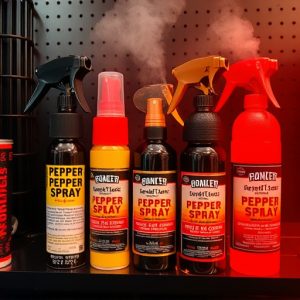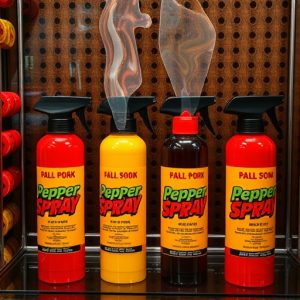Navigating Retail Compliance: Best Practices for Pepper Spray Displays
Retailers must carefully manage pepper spray displays to comply with a mosaic of state and local re…….
Retailers must carefully manage pepper spray displays to comply with a mosaic of state and local regulations that dictate who can purchase self-defense tools, how they can be marketed and displayed, and at what ages they are available. Adherence to licensing, labeling, and legal handling requirements is non-negotiable for compliance. Retailers should stay abreast of legal updates due to the variability in laws across different jurisdictions. Proper staff training, inventory management according to legal constraints, and a retail environment that upholds safety standards are crucial. Pepper spray displays must be designed to be both accessible to eligible buyers and safely out of reach for minors, with clear informative signage explaining proper usage and legal restrictions. Interactive elements like virtual reality demonstrations or detailed product information can enhance the shopping experience, ensuring customers are well-informed about pepper spray use. Effective marketing, tailored to stand out in the marketplace, combined with robust educational initiatives, makes pepper spray displays not just a retail item but a comprehensive resource for personal security, guiding consumers towards responsible and informed use.
When considering the integration of self-defense products like pepper spray into retail environments, it’s crucial to navigate the complex regulatory landscape that governs their display. This article delves into the nuances of presenting pepper spray displays responsibly while maintaining compliance with safety standards. We will explore effective strategies for designing these displays within retail settings and discuss the pivotal role of marketing and education in enhancing consumer safety and awareness. By understanding the intricacies involved, retailers can confidently showcase pepper spray products in a manner that aligns with legal requirements and promotes informed purchasing decisions.
Understanding the Regulatory Landscape of Pepper Spray Displays in Retail Stores
When integrating pepper spray displays into retail store environments, it is imperative to navigate the complex regulatory framework governing their sale and exhibition. These sprays are considered self-defense products and are subject to various state and local laws that dictate not only who may purchase them but also how they can be marketed and displayed within a commercial space. Retailers must ensure compliance with these regulations, which often include age restrictions for buyers, licensing requirements for the sale of defensive sprays, and clear labeling of the product’s capabilities and limitations.
The regulatory landscape is not uniform across all jurisdictions, necessitating careful attention to local laws. Retailers must stay informed about legal updates and ensure that their pepper spray displays are consistently updated to reflect current regulations. This may involve training staff on the legal parameters of selling these products, managing inventory based on lawful availability, and maintaining an environment that is both safe for customers and in line with legal standards. By adhering to these regulatory guidelines, retailers can responsibly offer pepper spray displays to consumers who seek them for legitimate self-defense purposes.
Designing Effective and Compliant Pepper Spray Display Strategies for Retail Environments
When integrating pepper spray displays into retail environments, it’s crucial to balance visibility and compliance with safety regulations. Effective display strategies should prioritize clear accessibility for potential buyers while ensuring the products are displayed responsibly. The design of these displays must adhere to local laws regarding the sale and presentation of self-defense items. Retailers can opt for countertop displays that draw attention without compromising on customer flow or store safety. These displays should be crafted from materials that prevent accidental activation and include informative signage that educates shoppers on proper usage and legal restrictions. Additionally, the placement of pepper spray displays must consider high-traffic areas where they can be easily seen by customers, yet remain out of reach of children, as per mandated safety standards. By focusing on these design elements, retailers can create an informative and compliant pepper spray display that enhances the shopping experience while promoting personal safety.
Incorporating interactive elements such as virtual reality demonstrations or detailed product information can further engage customers with pepper spray displays. Such features not only provide a hands-on learning opportunity but also differentiate the retailer’s approach from competitors. It’s important that these displays are integrated thoughtfully, maintaining an atmosphere of safety and trust within the store. By combining informative content with strategically placed pepper spray displays, retailers can effectively communicate the value and utility of these products to their customers while ensuring full compliance with industry standards and regulations.
The Role of Marketing and Education in Pepper Spray Display Presentations for Consumer Safety and Awareness
When presenting pepper spray displays in retail environments, marketing and education play pivotal roles in enhancing consumer safety and awareness. Effective marketing strategies are essential to draw attention to the pepper spray displays, ensuring they stand out amidst other products on the shelf. Retailers can utilize various visual and textual cues that resonate with potential buyers, emphasizing the practicality and importance of personal defense tools. High-quality signage that clearly states the purpose and function of the pepper spray, along with demonstration units that allow customers to see the product in action, can significantly increase engagement and understanding.
Educational components are equally important within these displays. They should aim to inform consumers about the proper use of pepper spray, its legal implications, and the circumstances under which it is most effective as a self-defense measure. This education can be facilitated through in-store demonstrations, instructional pamphlets, or digital content accessible via QR codes on the displays. By combining marketing with education, retailers not only boost sales but also empower consumers with knowledge that promotes responsible use and contributes to their overall safety. This dual approach ensures that pepper spray displays serve as more than just a product showcase; they become a resource for potential users to make informed decisions about their personal security.


